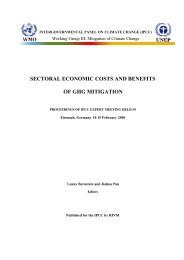Pacific Islands Environment Outlook - UNEP
Pacific Islands Environment Outlook - UNEP
Pacific Islands Environment Outlook - UNEP
Create successful ePaper yourself
Turn your PDF publications into a flip-book with our unique Google optimized e-Paper software.
8<br />
STATE OF THE ENVIRONMENT<br />
Box 1.1: Logging in Solomon <strong>Islands</strong><br />
Deforestation and forest degradation in Solomon <strong>Islands</strong> provide a<br />
good example of a failure adequately to consider the environmental<br />
and social costs of logging. Logging for export started in 1961, and<br />
has accelerated over the past few years. Half the viable (non-steepsloped)<br />
resource has now been logged, with extraction rates having<br />
almost doubled between 1991 and 1992. At current rates, harvesting<br />
cannot be sustained for more than eight years and the cessation of<br />
logging is likely to produce a significant drop in national income and<br />
output. A recent economic assessment by the ADB estimates<br />
sustainable annual yields at 270 000 m 3 , yet logging licences have<br />
been granted for up to 1.4 million m 3 per annum. Reforestation or<br />
regeneration of the forests will take 30–40 years in those areas that<br />
have been carefully logged. There has been widespread damage to<br />
the residual forests and forest site productivity, with the result that<br />
reforestation or regeneration may take anything from 45 to 200 years.<br />
Significant under-reporting of volumes and values has eroded the<br />
returns to Solomon <strong>Islands</strong> in the form of royalties and export tax. No<br />
significant environmental analysis has been used as an input into<br />
decisions on logging in Solomon <strong>Islands</strong>, despite available evidence<br />
from other parts of the world which indicate that the costs, in similar<br />
circumstances, can be substantial.<br />
Source: UNDP (1994)<br />
medicinal and food plants; capturing animals for food, and<br />
sometimes for textile production. Loss of forest habitat<br />
reduces the availability of medicinal plants and gathered<br />
foodstuff, negatively affects wildlife, and can have a<br />
negative impact on family nutrition, with the result that<br />
women are faced with more health care responsibilities.<br />
When forests are logged and land is allowed to degrade,<br />
subsistence gardens must be moved further from villages,<br />
and fuel wood must be carried longer distances. This<br />
significantly increases women’s work loads and can have a<br />
negative impact on women’s health and their ability to<br />
meet family and community responsibilities. Additional<br />
social problems can result from medium- and large-scale<br />
forest development, including breakdowns of traditional<br />
systems of social sanctions and, as men gain income, an<br />
increase in alcohol consumption (which is often linked to<br />
an increase in violence against women). Deforestation and<br />
forest degradation are also known to be associated with<br />
increased flash floods and low flows of rivers and streams.<br />
Trends forecast to 2010<br />
Since the commercial extraction of logs has been<br />
largely driven by offshore demand, particularly in the<br />
expanding Asian economies, it is of some interest to see<br />
how the economic downturn in that region will affect<br />
the rate of timber extraction. Anecdotal evidence<br />
suggests that in PNG some operators have faded from<br />
the scene, whilst (legal) operations were assisted in<br />
that country and in the Solomon <strong>Islands</strong> when their<br />
currency was devalued to offset the impact of the<br />
economic difficulties in south-east Asia.<br />
In the larger island countries, particularly in PNG,<br />
Solomon <strong>Islands</strong> and Vanuatu, efforts to reduce the<br />
rate of logging to more sustainable levels, to implement<br />
the codes of logging practice, and to develop and<br />
implement other sustainable forest management<br />
measures (e.g. criteria and indicators, forest<br />
certification) are expected to continue. The success of<br />
these measures will be affected by continuing pressure<br />
on these governments to maintain a relatively high<br />
(and unsustainable) rate of logging in order to generate<br />
revenues needed for development and other<br />
programmes. Fiji will soon be ready to begin harvesting<br />
its mahogany plantations, and also to play a role in the<br />
on-going global efforts to demonstrate that sustainable<br />
forest management policies and practices can be<br />
developed and implemented.<br />
In the smaller island countries, it is likely that<br />
people’s awareness of the role of forests and trees in<br />
sustaining, and improving, the livelihoods of<br />
communities will increase, and greater efforts will be<br />
made to protect and enhance the remaining forest and<br />
tree resources.<br />
Conclusion<br />
Forests and trees throughout the <strong>Pacific</strong> region are<br />
being removed or degraded at an unsustainable rate. In<br />
some countries (such as Samoa), merchantable timber<br />
resources are forecast to run out before the end of this<br />
decade (GOWS 1994). In most countries, the rate of<br />
deforestation and forest degradation far outstrips the<br />
rate of reforestation, which has until recently focused<br />
primarily on plantation establishment. Greater<br />
emphasis should be placed on: reducing the rate of<br />
logging or tree cover removal to sustainable levels; the<br />
effective implementation of codes of logging practice<br />
and reduced impact harvesting techniques to reduce the<br />
adverse impacts of logging on social, environmental and<br />
biodiversity elements; and increased use of natural<br />
regeneration to provide the next forest crop. Greater<br />
emphasis should also be placed on the sustainable<br />
harvesting and development of NWFPs (e.g. food,<br />
medicines, clean water, biodiversity of flora and fauna)<br />
and services (e.g. coastal protection, habitat for wildlife,<br />
reduction of soil erosion, regulation of water flow and<br />
quality). Given the critical importance of forests and<br />
trees to the region – socially, economically and<br />
ecologically – it is imperative that the effective

















